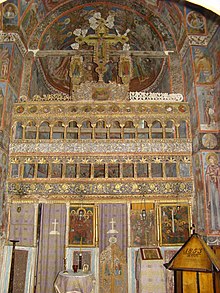Horezu Monastery
| Horezu Monastery | |
|---|---|
|
UNESCO world heritage |
|

|
|
| National territory: |
|
| Type: | Culture |
| Criteria : | (ii) |
| Surface: | 22.48 ha |
| Buffer zone: | 57.29 ha |
| Reference No .: | 597 |
| UNESCO region : | Europe and North America |
| History of enrollment | |
| Enrollment: | 1993 (session 17) |
The Monastery Horezu (also Monastery Hurezi called) is a Romanian Orthodox nuns convent and is in the historic region of Oltenia (dt. Also Oltenia , rum. Oltenia ) in county Valcea in Romania .
At the foot of the Munții Căpățânii , a mountain range in the Transylvanian Alps , on the area of the village Romanii de Jos , the monastery is about three kilometers (as the crow flies) north of the small town of Horezu .
history
The calls of the nocturnal birds of prey ( Romanian huhurezi ) that were in the surrounding forests of the monastery probably gave the place its name.
The monastery was founded in 1692 by the then Prince of Wallachia Constantin Brâncoveanu (1654–1714) and completed in 1709. It was a male monastery until 1862. After the monks were transferred to Bistrița, nuns came to the monastery. 48 nuns manage the facility where there is also a 50 bed rural hospital.
The in Brancoveanu style built monastery belongs since 1993 to UNESCO - World Heritage Site . The monastery complex has been restored several times since 1827 and is a listed building.
description
Located on a hill, the monastery complex is surrounded by two fortifications. The outer wall, a smaller one, surrounds the entire property of the monastery with its hermitages. The second is formed on three sides by buildings of different heights and a wall to the east. The entrance to the monastery is on the south side through a bell tower, which is equipped with a massive wooden gate armored with steel. The monastery church Sfinții Împarați Constantin și Elena built in the middle of the complex in the shape of a cross is 32 meters long, 14 meters high and was built between 1693 and 1697. In the vestibule of the church there are some tombs, most beautifully decorated with marble and with a carved cover for Prince Brâncoveanu, but they do not serve their purpose. The large iconostasis is carved in linden wood and covered with gold.
The square chapel with an octagonal tower, the windows of which are the light source of the chapel, is located on the west side opposite the entrance to the church and was built in 1697. The chapel's frescoes were created between 1705 and 1706 and are still in good condition today.
In addition to the church in the monastery, three chapels were built outside the monastery. To the east of the monastery is the small church Adormirea Maicii Domnului , donated in 1699 by Mrs. Maria - the wife of Prince Brâncoveanu - also called Bolnița , this is surrounded by a small curtain wall. The ruins of the former infirmary can also be seen here. About 500 meters north of the monastery is the Chapel of the Holy Apostles (built in 1698) and about 500 meters west, across the Romani brook , the Chapel of St. Stephen (built in 1703). Both are under monument protection.
Web links
- Web presentation of the Hurezi Monastery at arhiram.ro
- UNESCO entry
- Entry of unesco.org
- Thomas Veser: The Horezu Monastery is a Romanian national shrine in Wiener Zeitung ( Memento from September 30, 2007 in the Internet Archive )
Individual evidence
- ↑ George Ioan Lahovary: Marele Dicționar Geografic al Romîniei , Vol. III (p. 784), Bucharest 1900.
- ↑ a b List of historical monuments of the Romanian Ministry of Culture, updated 2010 (PDF; 7.10 MB)
- ↑ Information on the Hurezi monastery complex from crestinortodox.ro accessed on August 18, 2015 (Romanian)
- ↑ Information on Bolniță from crestinortodox.ro accessed on August 18, 2015 (Romanian)
Coordinates: 45 ° 10 ′ 9.4 ″ N , 24 ° 0 ′ 25 ″ E






